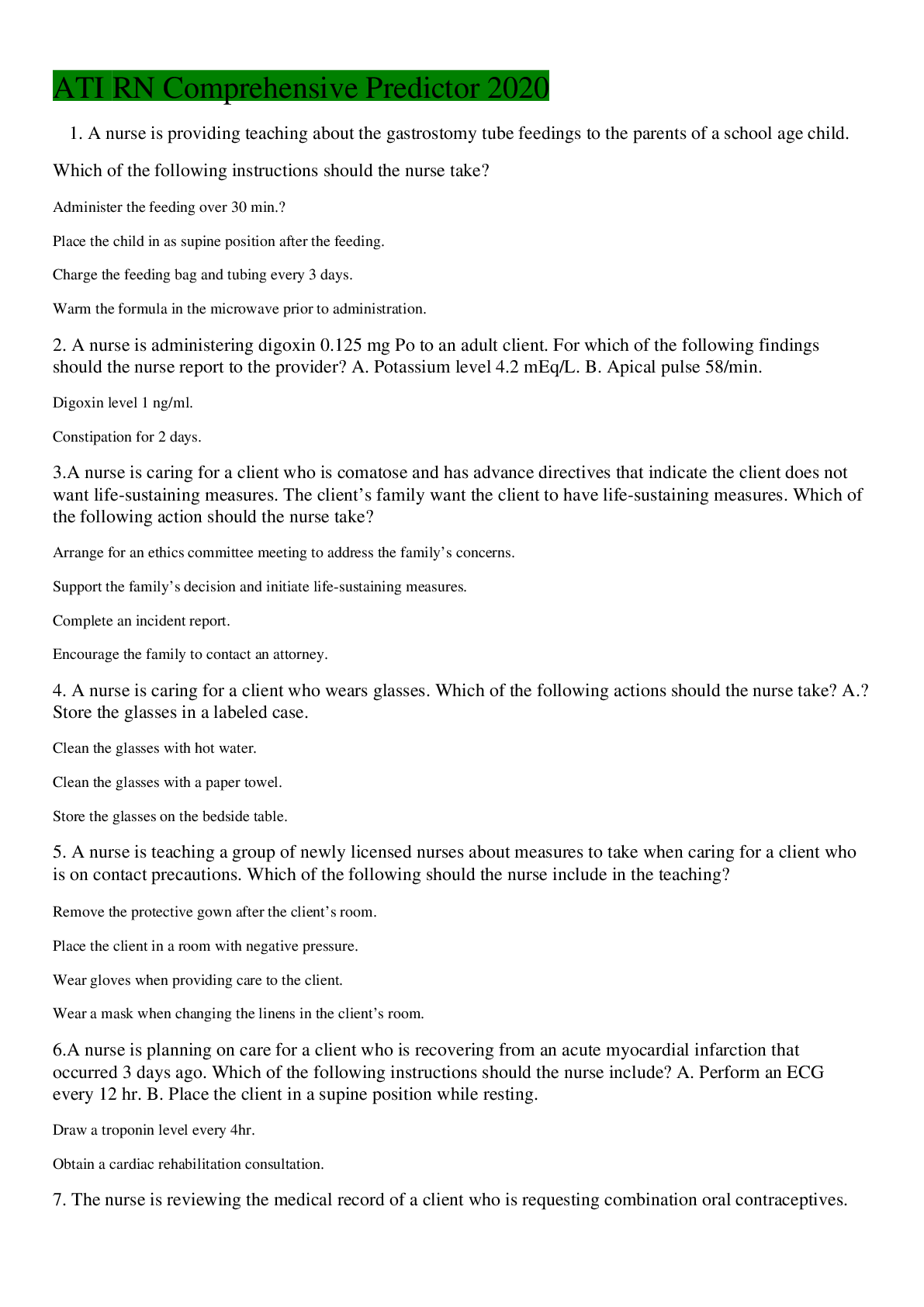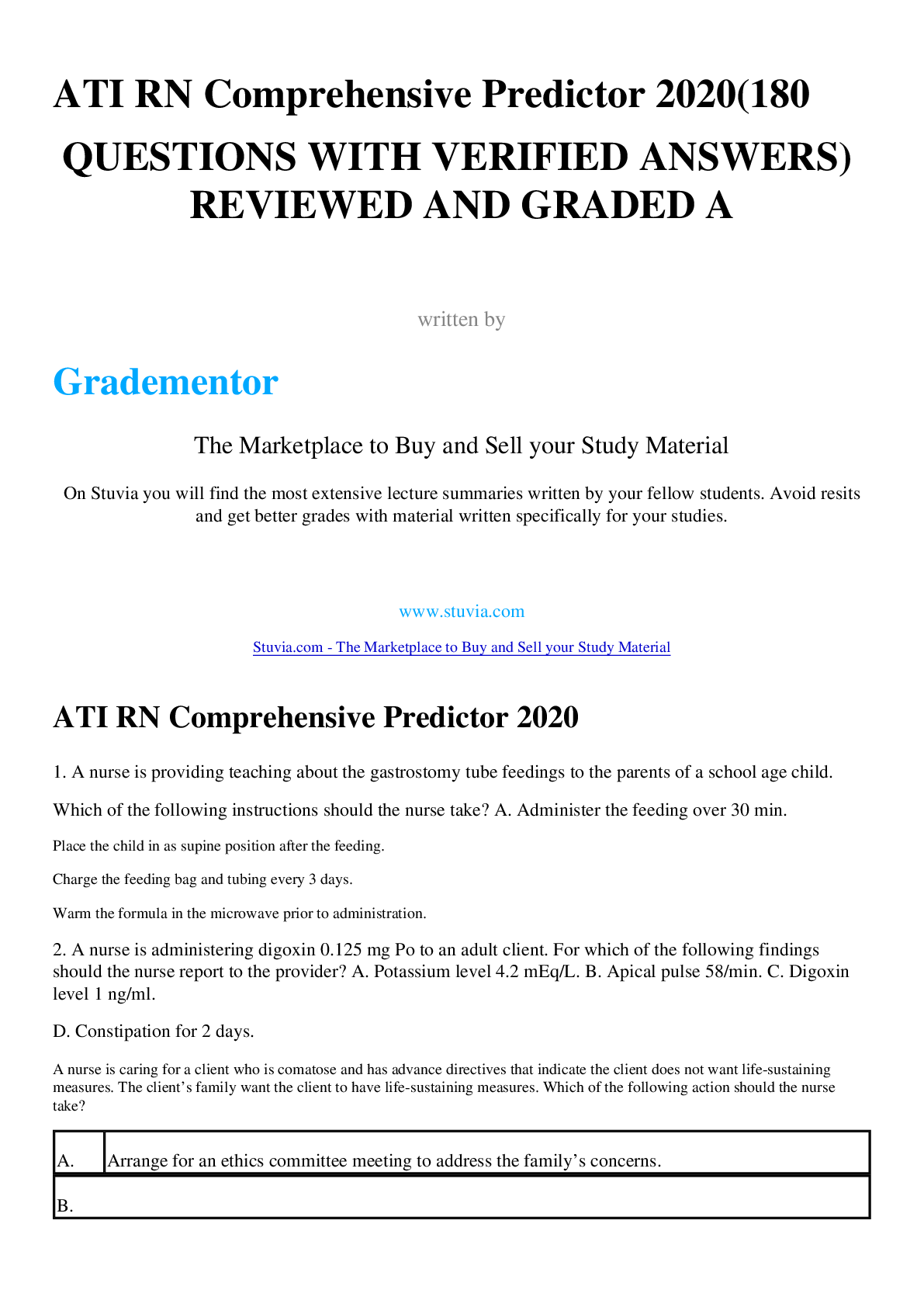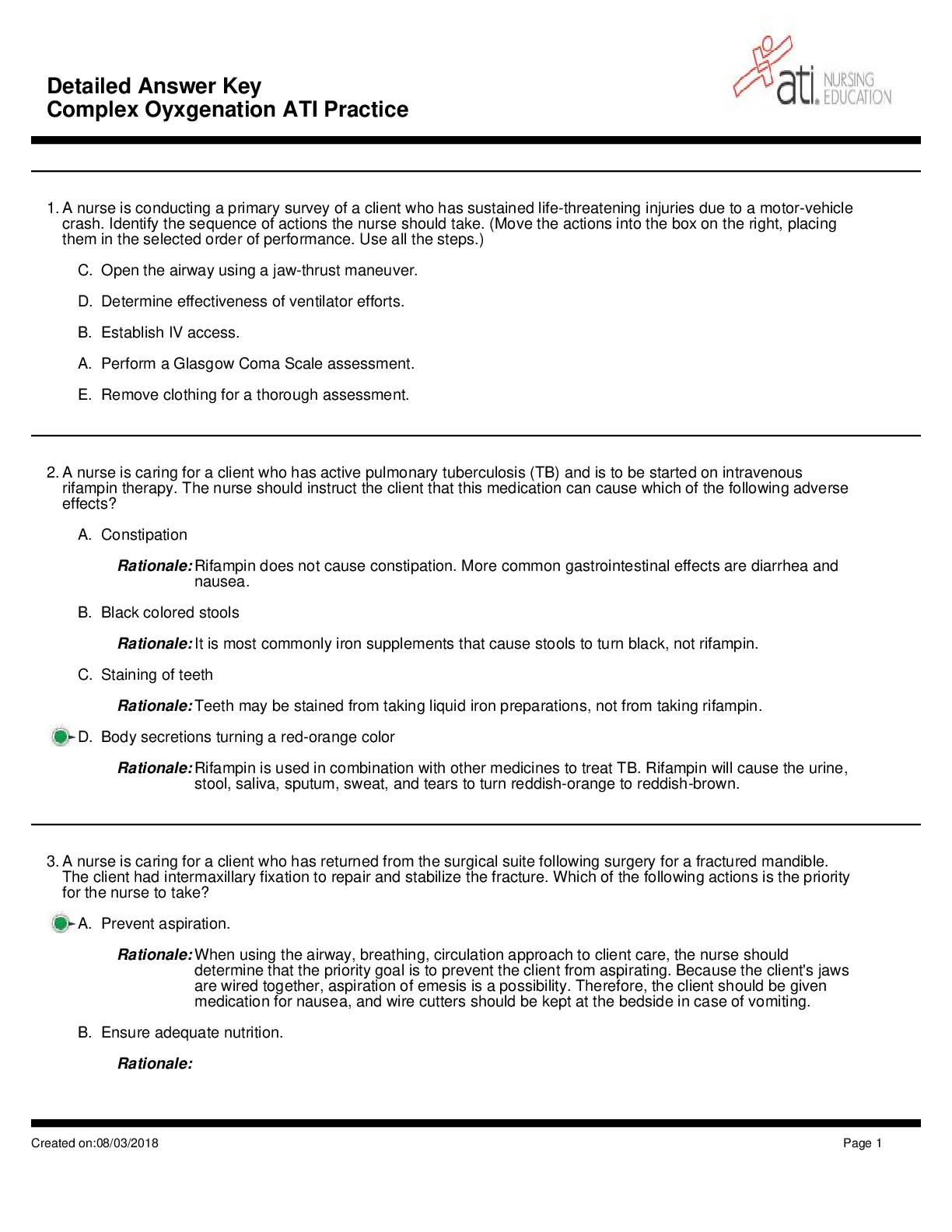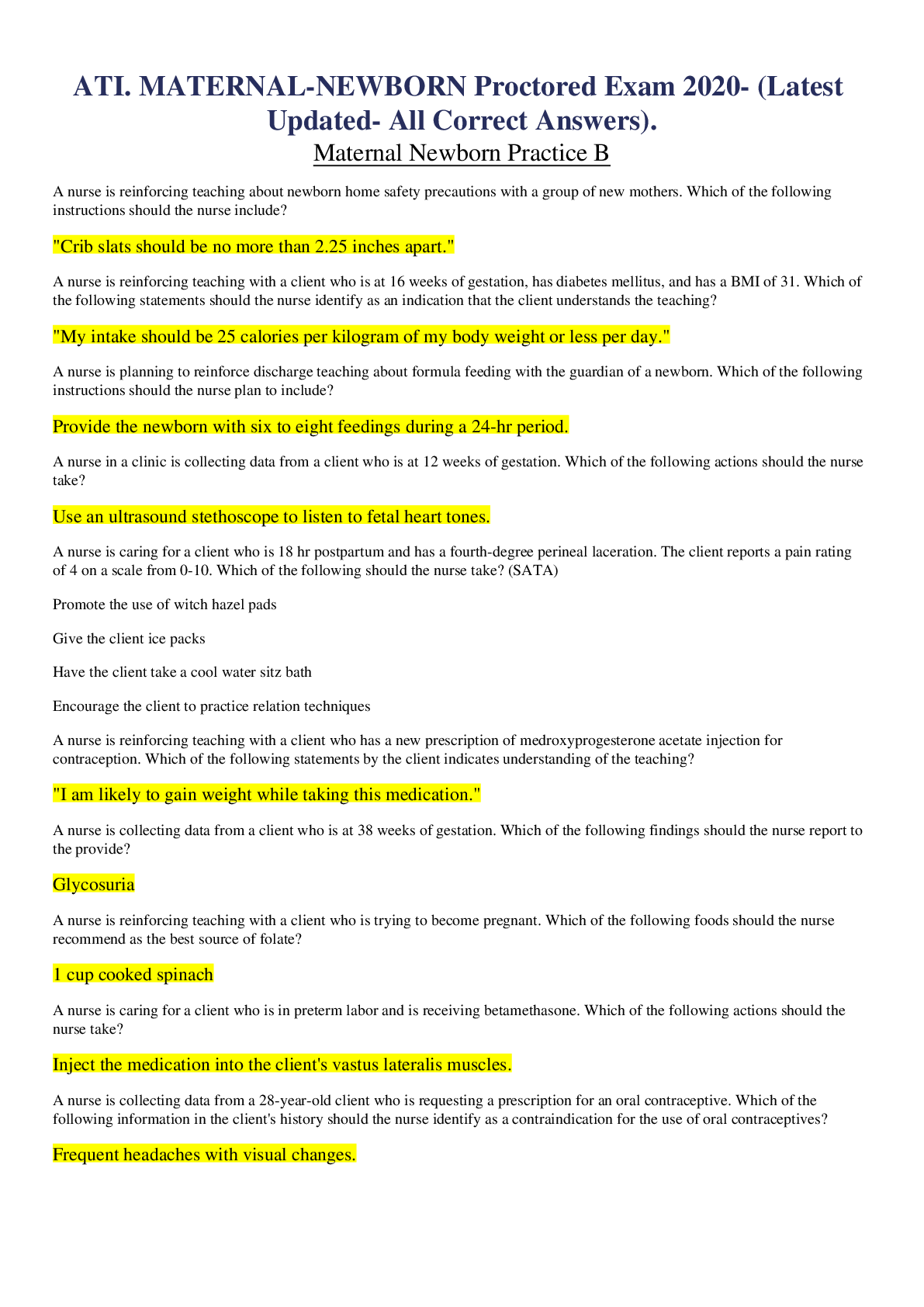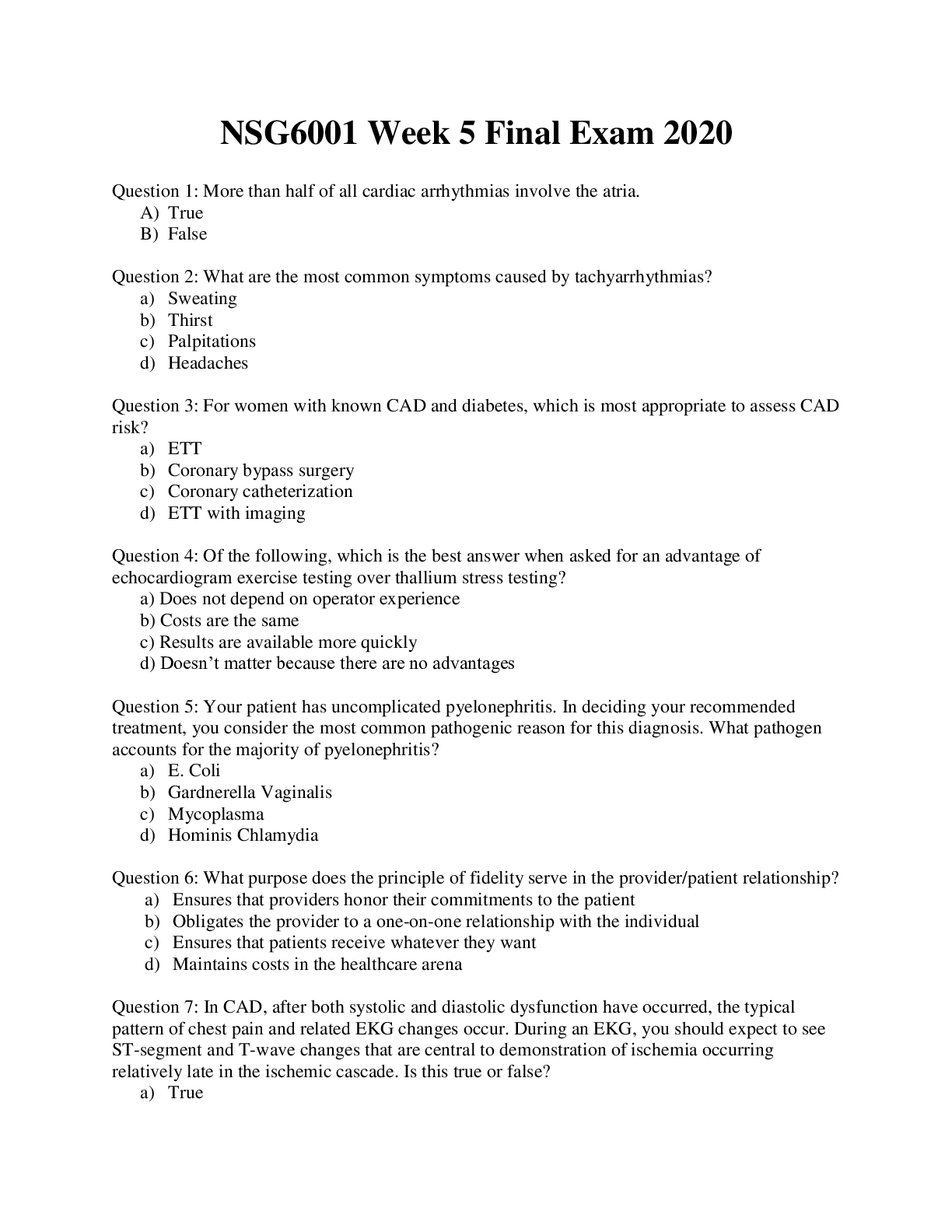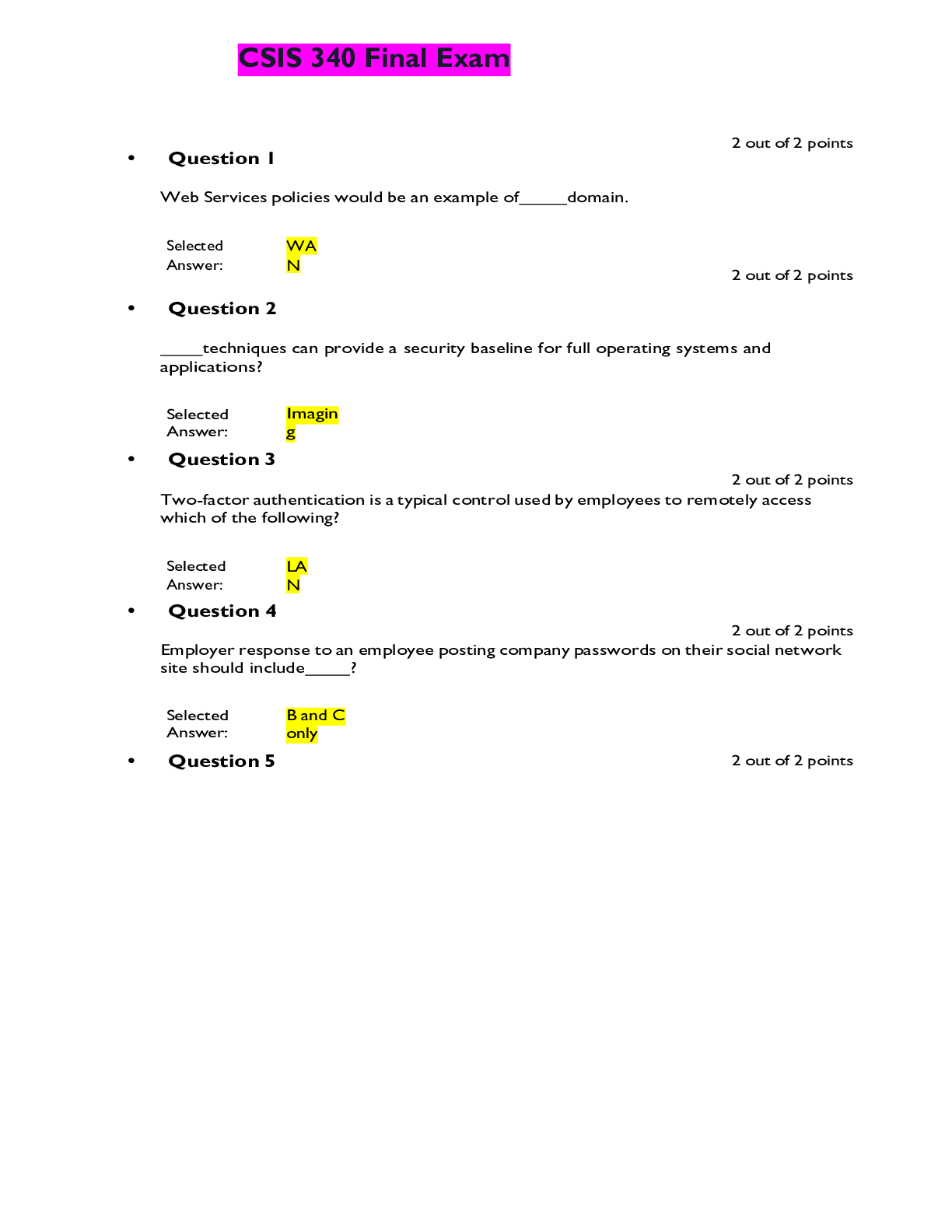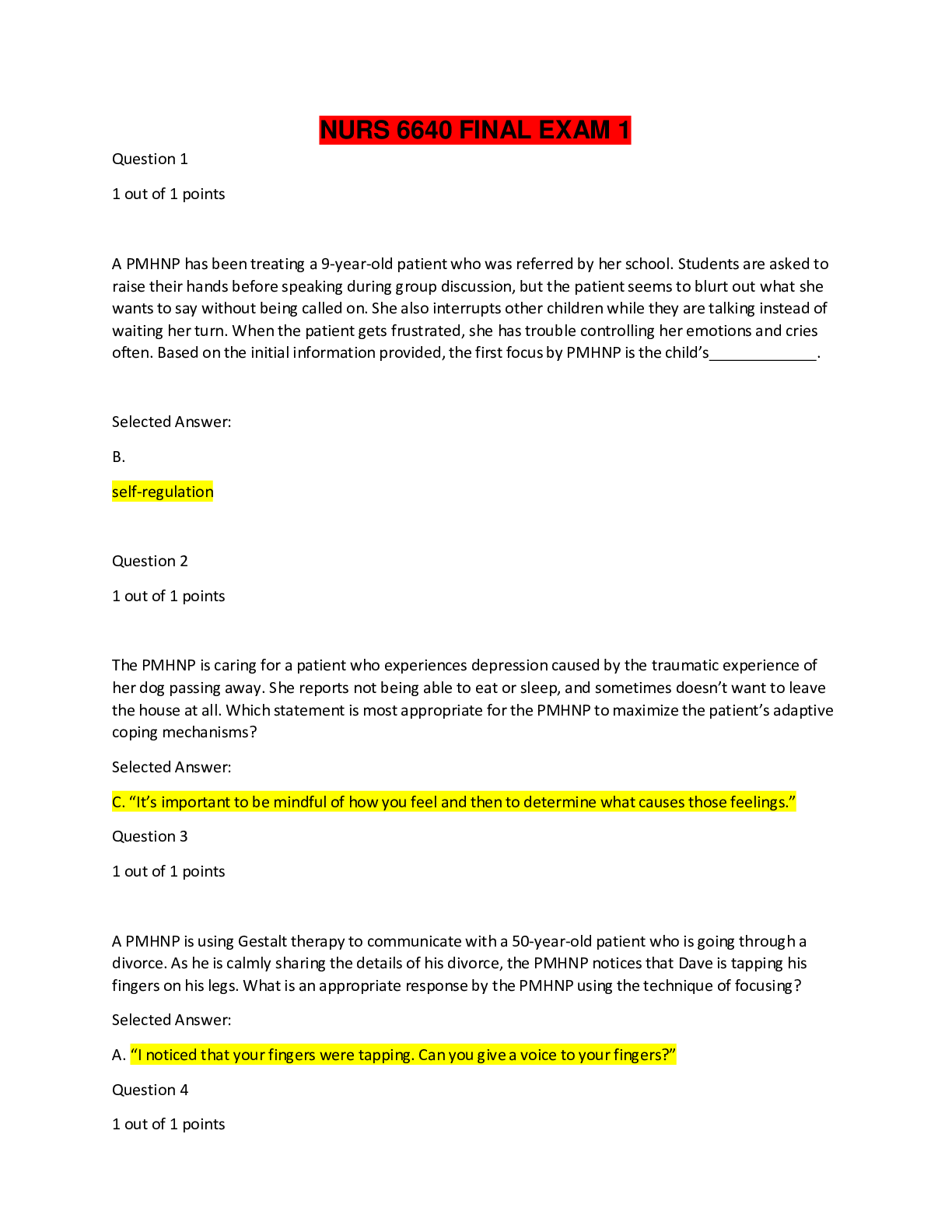Health Care > EXAM > COM 312 Midterm Exam 39 Questions with Verified Answers,100% CORRECT (All)
COM 312 Midterm Exam 39 Questions with Verified Answers,100% CORRECT
Document Content and Description Below
COM 312 Midterm Exam 39 Questions with Verified Answers What are the components of the definition of interpersonal conflict? - CORRECT ANSWER a problematic situation with the following characterist... ics: -the conflicting parties are interdependent -they seek incompatible goals or outcomes or they favor incompatible means to the same ends. -there is a sense of urgency about the need to resolves what are the stages of successful conflict and what is involved in each? - CORRECT ANSWER -competent communicators not only try to repeat the skill, they are also able to perform -how are you going to communicate? -meta conflict: you can look back on conflicts you have experienced, and learn from mistakes what is involved in the "process" view of conflict communication? - CORRECT ANSWER -triggering event: behavior that the parties in conflict forms the group for the conflict we are experiencing -initiation phase: conflict has become "overt" (one person makes known to the other that conflict exists -differentiation phase: participants use constructive or destructive strategies and tactics. (serves as as useful purpose by allowing parties to explain how they see the situation -resolution phase: those accept some out to the conflict (win-win) how do the linear and transactional views of conflict differ? - CORRECT ANSWER linear model: using words-- sender, receiver, channel, noise and feedback --emphasize the end product; it is a narrow view, we limit our view of interpersonal conflict as something we do to someone transactional model: managing and coordinating --exchange of verbal and nonverbal messages --implication- we view communicators as working together PRIMARY DIFFERENCE: linear model is a conveyor belt, transactional model, communication is seen more as a dance that 2 people do together define civility - CORRECT ANSWER constituted by an attitude of respect toward others manifested in our behavior toward them. --commitment to learn --attentive, acknowledging, thinking the best of others, listening, inclusive, kind works, apologize when necessary define incompatible goals - CORRECT ANSWER occur when we are seeking outcomes --i.e. we want to buy a different car, but can only afford to but one OR deciding on where to take a trip what are the functional and dysfunctional conflict cycles? - CORRECT ANSWER dysfunctional conflict cycles: are scripted - confrontation avoidance/accommodation- those who first impulse is to avoid initiating conflict or to quickly give in -avoidance -communication apprehension -accommodating -gunnysacking what is the "preferred" approach? - CORRECT ANSWER Collaboration how does collaboration relate to goal achievement? - CORRECT ANSWER -use low avoidance and high collaboration, show preparedness to use accommodation - genuine and mutual understanding -committed to a win-win solution rigid in terms of the goal of developing mutually satisfying solutions, but are flexible on how to achieve them.` what are scripts? - CORRECT ANSWER routine events that we perform with little deviation each time that we do them. -- behaviors are repeated what is involved in attribution theory? - CORRECT ANSWER stakes that people act as they do in conflict situations because of their inferences -disapprove of your actions-internal attribution: name calling -approval of the behavior- external: avoid blame -attributions affect the way people define conflicts attribution error: trying to blame it on someone else what is involved in social exchange theory? - CORRECT ANSWER behaviors are chosen due to self-interest-- maximize rewards while minimizing costs (cooperative joint action) -what does the relationship have to offer me? comparison level - CORRECT ANSWER people determine how satisfactory or attractive a relationship is. -reflects what people think they deserve comparison level for alternatives - CORRECT ANSWER when a 3rd party enters the picture--may lead to the examination of a current relationship four insights - CORRECT ANSWER 1. recognize that people are often quite rational about the way they "do" conflict 2. it is not possible for social exchange theory to take steps to resolve a conflict without restriction from the other person involved 3. conflict isa situation in which moves or countermoves take place 4. people in conflicts choose actions based not only on their particular rewards but, also on costs define false conflict - CORRECT ANSWER uncertainty helps to explain -occurs when one person is in an interdependent relationship -there in limited knowledge on the conflict --trust others, reduce uncertainty by engaging in "imagine interactions" how does defensiveness relate to listening? - CORRECT ANSWER listening- focus one's attention on the other person.. willingness to suspend judgment defensiveness- state of emotional arousal that occurs when we believe the other person is attacking us ***listening is a way of reducing both our own and others defensiveness list of basic communication rights - CORRECT ANSWER -listen and be taken seriously -say no -be treated as an adult -not spoken to condescendingly -feel your own feelings -express interests -change your opinion -meet others -not confront someone what is involved in empathy - CORRECT ANSWER -considering others point of view -consider another person's beliefs or feelings, so that we can see the situation -it does NOT require that we agree what types of goals are relevant to conflict? - CORRECT ANSWER instrumental: require the opponent to "remove a specific obstacle blocking the task" (wanting the teacher to change your grade_ relational: attempt to gain power and est trust as the relationship is established identity: how those in a conflict view each other process: alternative ways to manage conflict S-TLC steps for dealing with conflict situations - CORRECT ANSWER Stop: taking a timeout Think: what does the conflict means that you consider its cause and possible outcomes before you take action Listen: focus one's attention on the other persons Communicate: speak up for one's interests, concerns, or rights in a way that does not interfere with the interests or infringes on the rights of others define power - CORRECT ANSWER the ability to influence or control events what is legitimate power - CORRECT ANSWER power derived from your formal position within an organization powerful speech - CORRECT ANSWER refers to verbal and nonverbal messages used to dominate and control others powerless speech - CORRECT ANSWER talking up to others, making requests or asking questions, speaking softly, and sounding tentative, uncertain or unsure of oneself neutral speech - CORRECT ANSWER where he or she does not talk down or talk up to others but talks to them as equals and relies on objective language what is groupthink? - CORRECT ANSWER when people are committed to the people, goals and or ideals of a group that they fail to engage in conflict when they should what are ways of abusing power? - CORRECT ANSWER 1. to give up some of the obvious power resources and symbols of authority (abandon podium) 2. make power resources accessible to everyone in the group (turnover responsibilities) 3. the more powerful person can give power to the relationship that exists between the friends, and romantic partners.. taking into consideration on how they behave define face - CORRECT ANSWER the image people have of themselves what are the types of face and what is involved in each? - CORRECT ANSWER positive face: our belief that we are like-able and worthy of others respect autonomous face: part of us that wants some independence, privacy, and recognition for our contributions or time alone what tare the types of face management and what is involved in each? - CORRECT ANSWER 1. positive face: occurs when we work to et other people to like and respect us 2. autonomous face: when we try to get other people to recognize, encourage, support, and approve our autonomous face needs 3. preventative face: forestalls becoming embroiled in face saving issues during conflict situations 4. supportive face: to help reinforce the way the other is presenting him or herself 5. corrective face: statements meant to ameliorate the effect of face-threatening messages what is a repair ritual? - CORRECT ANSWER specialized version of the conflict process where a triggering event is follow by initiation, differentiation, and perhaps resolution what are the steps in the repair sequence - CORRECT ANSWER 1. offending situation: those in which a person believes that the other has acted in an intentionally hurtful way 2. reproach: request for an explanation of an offense from the one offended 3. remedy: an account, concession, or apology supplied by an offender 4. acknowledgment: evaluation of the account supplied by the one offended 5 basic conflict styles - CORRECT ANSWER 1. competing: high concern for self, WANT POWER (win-lose) 2. accommodating: a concern for others (lose/win 3. avoiding: no concern for self/others (lose/lose) 4. compromising: concern for self and others, tradeoffs? "middle road" (part win-part lose OR lose-lose) 5. collaboration: self and others "what are the options" (win-win) what occurs in each stage of Gottman's "4 horsemen of the apocalypse" - CORRECT ANSWER 1. criticism 2. defensiveness 3. contempt: they don't matter (predictor of divorce, illness, breakups) 4. stonewalling: no response what are the types of conflict, as defined by Deutsch? what is involved in each? - CORRECT ANSWER 1. parallel: accurately perceived 2. displaced: not over the actual issue but over the symptom (displaced) 3. misattributed: inaccurate perception by one or both parties 4. latent: actual basis but unperceived 5. false: perception of something that is not true (asking for clarity) define assertiveness. what are its advantages? when should it be used? - CORRECT ANSWER sharing your position honestly, while respecting others -"I" messages, no-mind reading (no making assumptions) - not always the best idea, but you do have an advantage - situationally assertive: rewards for passiveness=nothing is your fault. Describe assertive techniques - CORRECT ANSWER broken record: establishing your position on repeat 53rd choice: saying "no", offer no reason fogging: no resistance.. you agree to the other person's point of view toward you the sandwich: always use "I" statements --postive FB, ZINGER (negative), positive, expression of confidence what are the basic goals of civil dialogue? - CORRECT ANSWER not based on facts -goal is productive-- passionate, not hostile. focus on how it make YOU feel, avoid framing it as an argument [Show More]
Last updated: 5 months ago
Preview 1 out of 7 pages
Instant download
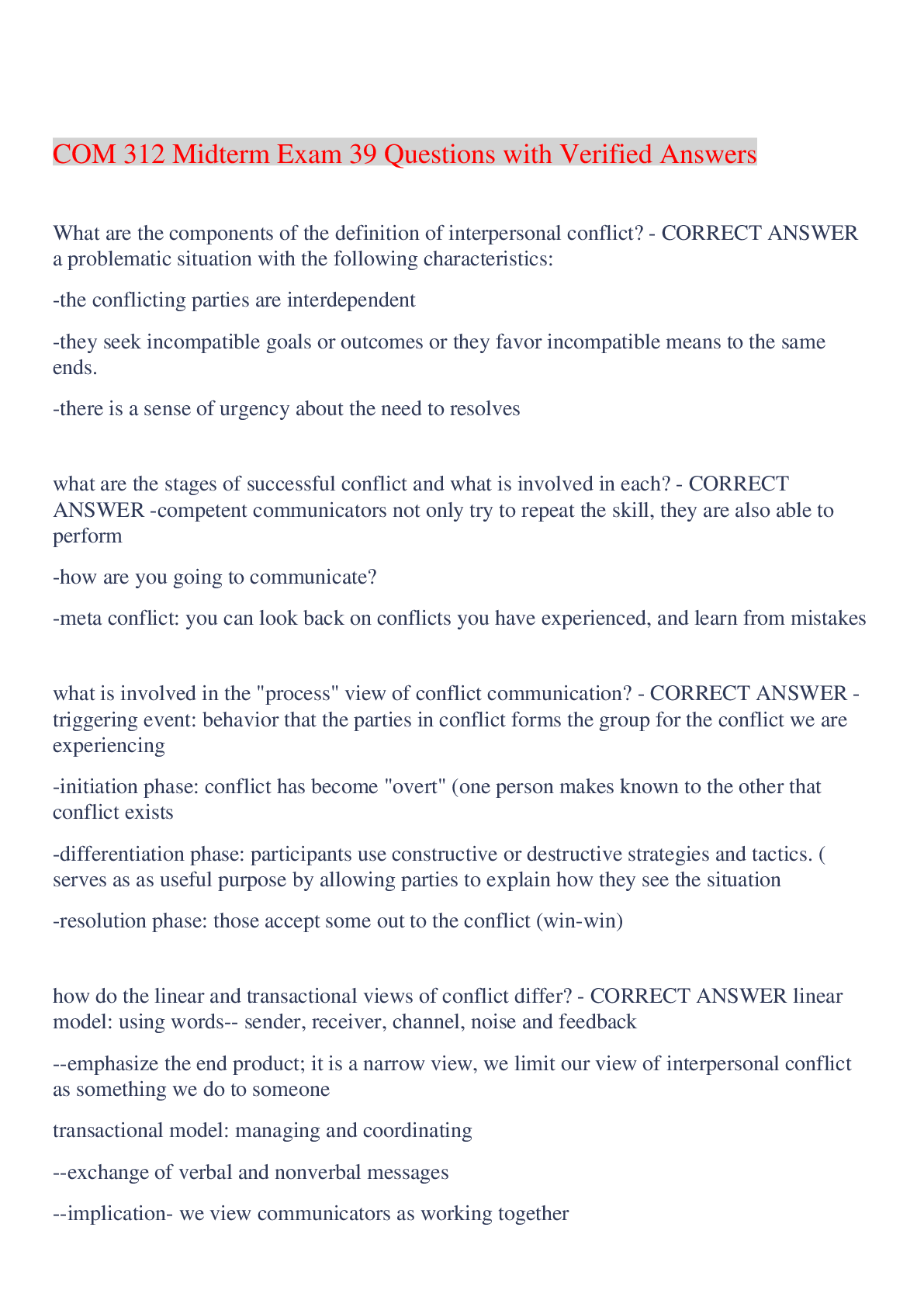
Buy this document to get the full access instantly
Instant Download Access after purchase
Add to cartInstant download
Reviews( 0 )
Document information
Connected school, study & course
About the document
Uploaded On
Dec 15, 2023
Number of pages
7
Written in
Additional information
This document has been written for:
Uploaded
Dec 15, 2023
Downloads
0
Views
42













